Optimal shaped windshield washer tanks
Typically, in passenger cars, the windshield washer tanks are three to five litres. For buses and coaches, however, the volume of these tanks is much larger. Often, they contain 30 litres or more. This gives the designers a challenge because the highest priority is to get as much space as possible for the passengers and their luggage. Because of that, a washer fluid tank must often be oft fitted in an odd-shaped space that is left at the final stage. The unique advantages of rotomoulding come in handy here. The design freedom with this technology is huge. It creates the opportunity to utilize the available space and create the desired large volume windshield washer tanks.


Freeze-resistant windshield washer reservoirs
Normally a windshield wiper fluid container is filled with water and anti-freeze. This is called an ethylene glycol water mixture. Polyethylene has an excellent chemical resistance against ethylene glycol water mixtures. When no anti-freeze is added by accident, the tank content may freeze, and the ice will expand. The extreme tough polyethylene material will withstand this and will not crack.
Accurate 3D scanning service for rotomoulded premium products
At Rotovia, we offer a comprehensive 3D scanning service, from physical scanning to post-processing. Our scanning service accurately measures rotomoulded products in 3D, providing extremely accurate measurement data. With this service, our customers not only gain precise 3D models of their custom moulded products, but also the ability to use the collected information in the design or quality control process.
Find out more


A one-piece multi-function washer fluid tank
To pump the anti-freeze to the windscreen or head lights, a pump is mounted on the windshield washer reservoirs. To create space for the pump a recess is moulded in the tank where the pump fits in exactly. With some simple snap nocks no additional assembly parts are needed. In the bottom of the recessed area a hole is drilled, where the suction foot of the pump is mounted with a watertight rubber collar.
Furthermore, a filling neck with screw thread for a screw cap is also formed at the top of the tank, or a hose tail over which a filling hose can be mounted. Mounting feet are also formed to be able to mount the tank in the bus. In short, we create a one-piece tank with all necessary functions integrated.
For more details about rotomoulded windshield washer tanks, contact us today!

Julia
Sales Manager
"A satisfied customer is the best business strategy of all"
your idea
to life. Start now!


